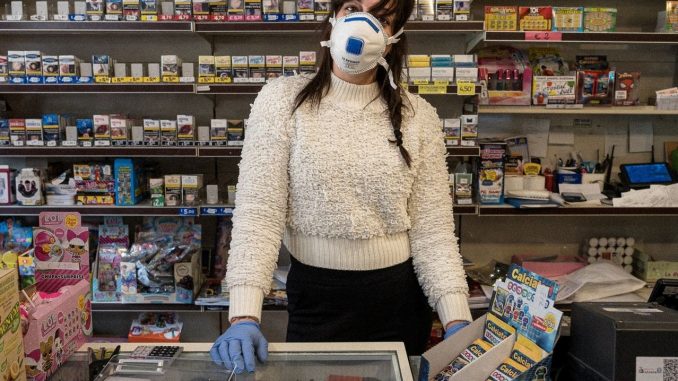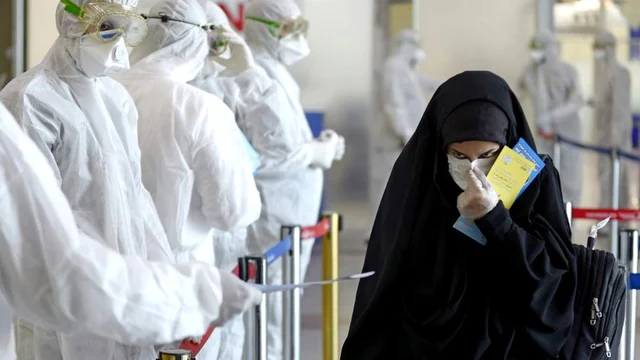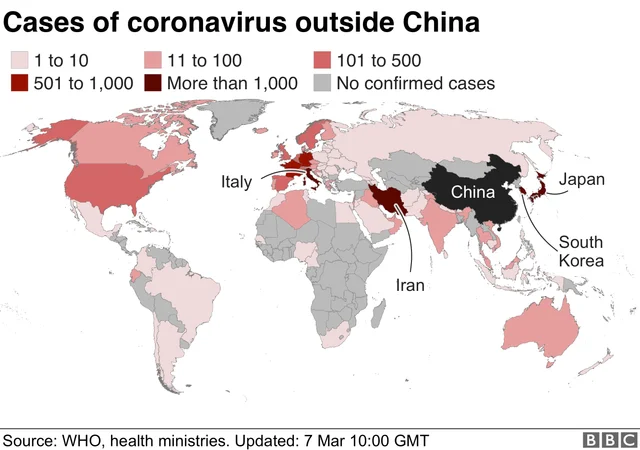
Italy has placed up to 16 million people under quarantine as it battles to contain the spread of coronavirus.
Anyone living in Lombardy and 14 other central and northern provinces will need special permission to travel. Milan and Venice are both affected.
Prime Minister Giuseppe Conte also announced the closure of schools, gyms, museums, nightclubs and other venues across the whole country.
The drastic measures will last until 3 April.
Italy has seen the largest number of coronavirus cases in Europe and reported a steep rise in infections on Saturday. The strict new quarantine measures affect a quarter of the Italian population and centre on the part of the country that powers its economy.
The death toll in Italy has passed 230, with officials reporting more than 36 deaths in 24 hours. The number of confirmed cases jumped by more than 1,200 to 5,883 on Saturday.
“We want to guarantee the health of our citizens. We understand that these measures will impose sacrifices, sometimes small and sometimes very big,” Mr Conte said early on Sunday.
“But this is a time where we must take responsibility for ourselves.”
Last week the government announced the closure of all schools and universities across the country for 10 days.
It was widely discussed here that the week that’s just finished was critical to seeing if Italy’s coronavirus response had managed to halt the spread. If the numbers had begun to tail off, it would have suggested the containment measures had worked. They haven’t.
With cases still surging, the government has moved to the next stage – and it’s a dramatic step up. It’s not quite a complete lockdown – planes and trains are still running and access will be permitted for emergency or essential work reasons. But police will be able to stop people and ask why they’re trying to enter or leave the areas covered.
The question is whether this is all too late. It’s believed the virus was circulating in Italy for weeks before it was detected. And there have now been cases in all 22 regions of the country. The government is now taking the most extensive containment measures outside of China. But is this a case of trying to shut the stable door after the horse has bolted?
Under the new measures, people will be unable to enter or leave the whole northern region of Lombardy, home to 10 million people, except for emergency access. Milan is the main city in the region.
Mr Conte said the 14 provinces affected were Modena, Parma, Piacenza, Reggio Emilia, Rimini, Pesaro and Urbino, Alessandria, Asti, Novara, Verbano Cusio Ossola, Vercelli, Padua, Treviso and Venice.
“There will be no movement in or out of these areas, or within them, unless for proven, work-related reasons emergencies or health reasons,” Mr Conte told reporters.
“We are facing an emergency, a national emergency. We have to limit the spread of the virus and prevent our hospitals from being overwhelmed.”
Until now only around 50,000 people in northern Italy had been affected by quarantine measures.
What are the details?
Weddings and funerals have been suspended, as well as religious and cultural events. Cinemas, night clubs, gyms, swimming pools, museums and ski resorts have been closed.
Restaurants and cafes in the quarantined zones can open between 06:00 and 18:00 but customers must sit at least 1m (3ft) apart.
People have been told to stay at home as much as possible, and those who break the quarantine could face three months in jail.
The World Health Organization (WHO) has advised Italy to focus on virus containment measures as infections spread in the country.
The plans echo China’s forced quarantine of millions of people which the WHO has praised for halting the spread of the virus.

Italy has also said it will start recruiting retired doctors in an effort to combat the escalating outbreak.
What is the situation elsewhere?
Iran – another coronavirus hotspot – has now confirmed almost 6,000 infections and 145 deaths.
The number of infections worldwide is almost 102,000, the WHO says, with nearly 3,500 deaths. Most of the fatalities have been in China, where the virus originated in December.
WHO chief Tedros Adhanom Ghebreyesus has called the spread of the virus “deeply concerning” and urged all countries to make containment “their highest priority”.

On Sunday South Korean officials said 367 new cases had been reported in the past day, bringing the total cases in the country to 7,134.
China reported its lowest number of new infections in a single day since January. There were 27 new deaths there from the virus – all were in Wuhan, where the outbreak began.
In the US, a cruise ship with 3,533 passengers and crew is being held off the coast near San Francisco after 21 people tested positive for the disease.
Washington state reported two more fatalities, bringing the US death toll to 19.
In New York, cases jumped from 44 on Friday to 76 and Governor Andrew Cuomo declared a state of emergency.
South America recorded its first coronavirus death – a 64-year-old man in Argentina.
In Australia, a man in his 80s became the third person to die there from the virus.
Among other countries to report a rise in the total number of cases are: France (to 949); Germany (795); Spain (441); the UK (206); the Netherlands (188).
Colombia, Bulgaria, Costa Rica, Malta, the Maldives and Paraguay have meanwhile all reported their first cases.

*Story by BBC News